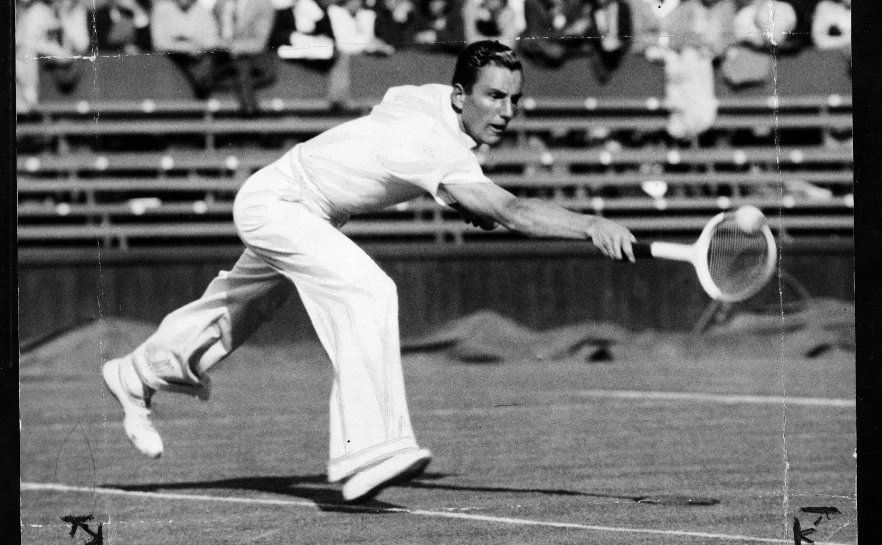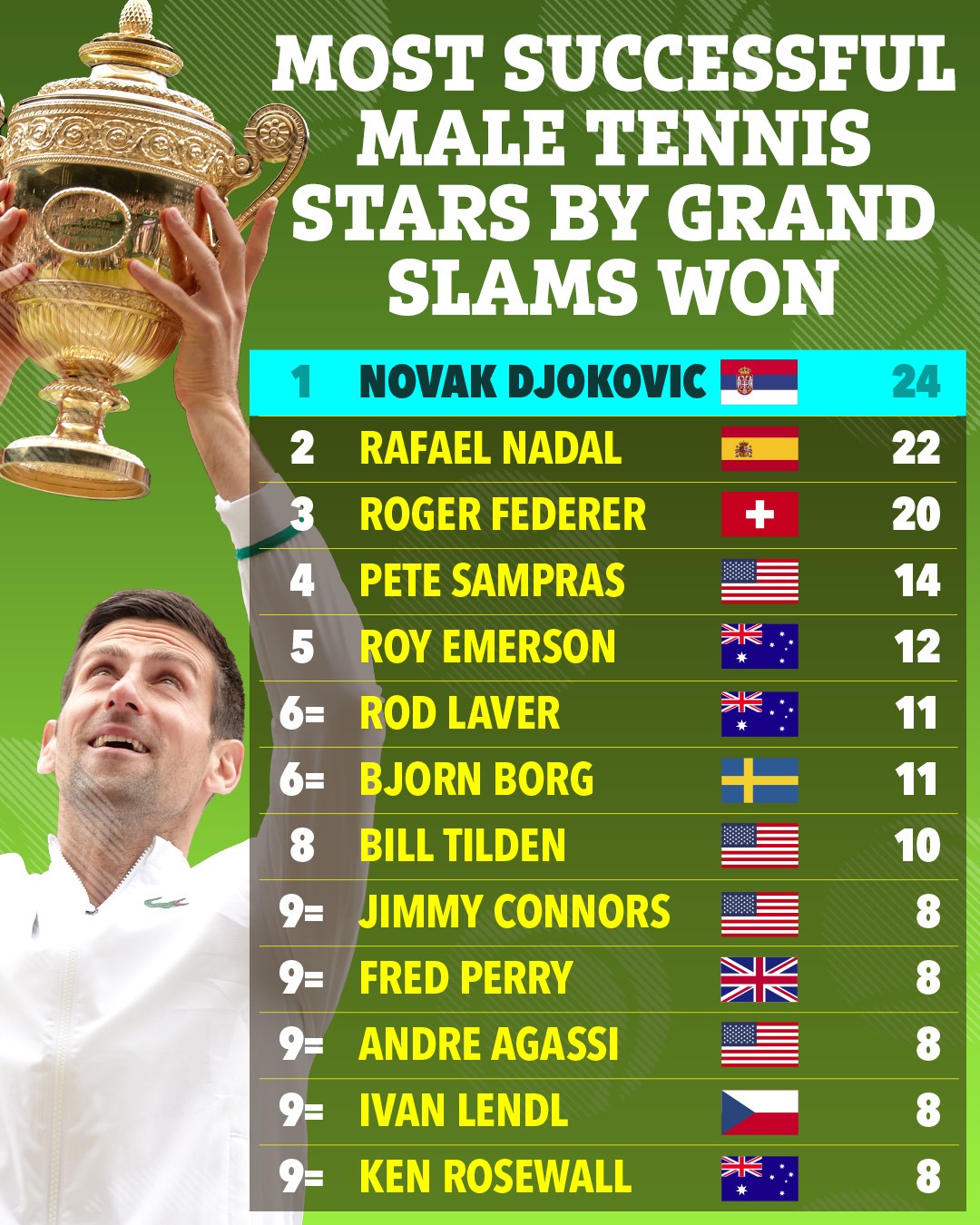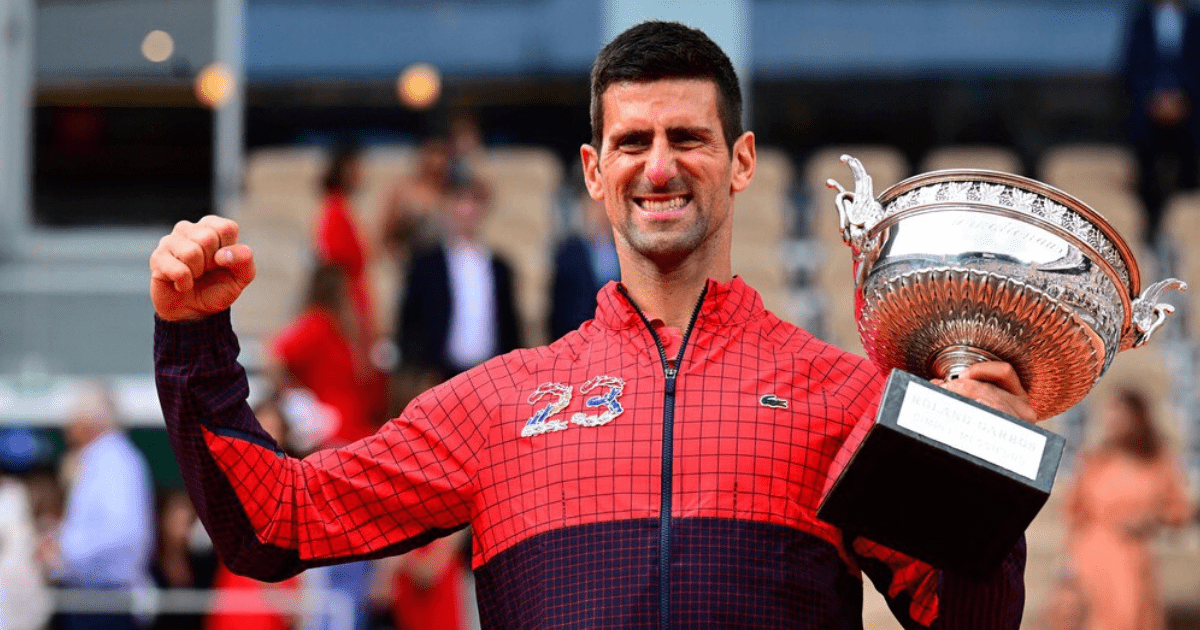WINNING a Grand Slam title is considered the absolute pinnacle of tennis.
Novak Djokovic is out to win a stunning 11th Australian Open title later this month final, but he'll have some tough obstacles in his way.
Djokovic was beaten by Carlos Alcaraz at last year's Wimbledon before bouncing back to win the US Open in record-breaking style.
Roger Federer has retired from the sport after a stunning career so he will no longer be able to add to his huge cabinet.

Rafael Nadal is still in action, but his best years also look to be behind him.
But who has won the most Grand Slams in men's tennis and how many are up for grabs each year?
Who has won most men's tennis Grand Slams?
In a game such as tennis where there is intense focus on the individual, making it through a world-class knockout tournament is no mean feat.
Andy Murray – Britain's most successful male player in the modern era – has won three Slams in his career but doesn't get near to the most successful on the list.

It's Fred Perry who is the Brits Grand Slam king with nine titles, level on the leaderboard with Ken Rosewall, Jimmy Connors, Ivan Lendl and Andre Agassi.
Bill Tilden comes next with ten, before Bjorn Borg and Rod Laver with eleven.
Roy Emerson – who won a total of 28 slam titles if you count doubles – holds 12 single titles and sits just behind the top four.
That leaves us with the current big three – Novak Djokovic, Roger Federer and Nadal – along with Pete Sampras.

Sampras has 14 titles to his name, Federer is on 20 triumphs whilst Djokovic's US Open win in 2023 has him out on 24.
Nadal now has 22 Grand Slam titles, with 14 of these coming at Roland Garos at the French Open.
Who has won the most Grand Slams?
Novak Djokovic – 24
Rafael Nadal – 22
Roger Federer – 20
Pete Sampras – 14
Roy Emerson – 12
Rod Laver – 11
Bjorn Borg – 11
Bill Tilden – 10
Jimmy Connors – 8
Fred Perry – 8
Andre Agassi – 8
Ivan Lendl – 8
Ken Rosewall – 8
How many Grand Slams are there each year?
There are a total of four Grand Slams every tennis season across four different countries:

- Australian Open
- French Open
- Wimbledon
- US Open
Frequently Asked Questions
How has tennis gear evolved over time?
Tennis equipment has undergone significant evolution since the game’s early days. The original rackets used animal intestines for the string. In the past, new materials such as graphite and titanium have been introduced to make rackets stronger and lighter. The balls have also changed, transitioning from hand-sewn to manufactured pressurized rubber that provides consistent bounce and flight. This evolution allows for a much more dynamic and athletic style of play.
What are the key components of tennis etiquette?
Tennis etiquette is an integral part of the game, reflecting both sportsmanship and respect. Players are expected to make honest calls on line rulings, avoid distractions during serves, remain silent during rallies, and shake hands cordially after the match. Audiences are also expected to follow this etiquette and remain silent during matches, while applauding the good shots of both competitors. The integrity of tennis and its gentlemanly tradition are preserved by following these unwritten guidelines.
What role have tennis icons played in popularizing the sport?
Tennis icons have played a pivotal role in popularizing the sport globally. Throughout its history, charismatic and skilled players like Billie Jean King, Rod Laver, Bjorn Borg, Martina Navratilova, Pete Sampras, Serena Williams, and Roger Federer have captured the public’s imagination. Their performances on court and personalities outside of it have not just drawn fans to this game, but also inspired younger players to take up tennis. Their legacy goes beyond their titles and has shaped the culture and market of tennis.
What is the impact of different surfaces on tennis matches?
Tennis matches are affected by the pace and style of play on different surfaces. Grass courts tend to produce a faster game favoring big servers and those with an attacking style. Clay courts are slower and have a higher bounce. This is good for baseline players and those with topspin and endurance. Hard courts offer a playing surface that is balanced, neither too fast or too slow. This rewards players who are well-rounded. These differences in surfaces can lead to different strategies, and even influence the outcome of matches.
Who was credited with standardizing today’s game of tennis?
Major Walter Clopton Wingfield owes a lot to the modernization of tennis. In 1873 he invented a game he called “Sphairistike”, which was played in an hourglass-shaped court. Wingfield’s version of the sport included a simplified system for scoring and similar equipment to that which is used today. This version of the game laid the foundations for modern lawn tennis rules. By 1877 the first Wimbledon Championships was held, cementing its rules and structure.
Statistics
- Graphite became a popular material for tennis racquets in the 1980s, with over 90% of professional players now using graphite or graphite composite racquets.
- The global tennis equipment market reached an estimated value of over 1 billion dollars, reflecting the sport’s widespread popularity.
- The International Tennis Federation (ITF) governs over 200 nations, indicating the sport’s vast international governance structure and participation rate.
- Lawn tennis, which evolved into the game we know today, adapted its point system from the jeu de paume, with theories suggesting its increments represent the face of a clock.
- As of 2023, Wimbledon remains the oldest tennis tournament in the world and is considered by many to be the most prestigious.
External Links
itftennis.com
tennis.com.au
bbc.com
wimbledon.com
atptour.com
How To
How to choose the right tennis racket for your game
Consider your playing style and skill level when choosing the right tennis racket. Beginners benefit from oversized rackets because they have a larger sweet-spot, while intermediates can use midplus rackets to balance power with control. For precision, advanced tennis players choose control or mid-size rackets. Also, check the weight, balance and pattern of the string. If you want to improve your tennis game, consulting a coach or racket specialists can help.

